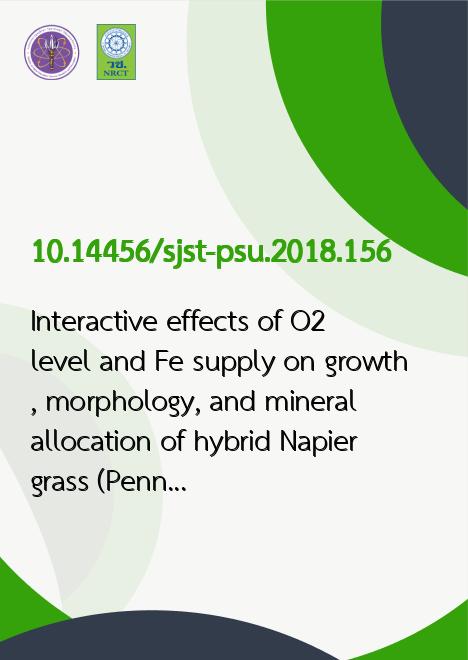
|
Interactive effects of O2 level and Fe supply on growth, morphology, and mineral allocation of hybrid Napier grass (Pennisetum purpureum ? P. americanum cv. Pakchong 1) |
|---|---|
| รหัสดีโอไอ | |
| Creator | 1. Janjira Muenrew 2. Arunothai Jampeetong |
| Title | Interactive effects of O2 level and Fe supply on growth, morphology, and mineral allocation of hybrid Napier grass (Pennisetum purpureum ? P. americanum cv. Pakchong 1) |
| Publisher | Research and Development Office, Prince of Songkla University |
| Publication Year | 2561 |
| Journal Title | Songklanakarin Journal of Science and Technology |
| Journal Vol. | 40 |
| Journal No. | 6 |
| Page no. | 1271-1280 |
| Keyword | aerenchyma, Fe toxicityN uptake rates, Pakchong 1, O2 stress |
| URL Website | http://rdo.psu.ac.th/sjstweb/index.php |
| ISSN | 0125-3395 |
| Abstract | Plants that grow on wastewater are affected not only by low O2 but also by the presence of iron leading to low efficiency for nutrient removing from the wastewater treatment systems. Currently, hybrid Napier grass (Pennisetum purpureum Schumach ? P. americanum (L.) Leeke cv. Pakchong 1) was introduced for use in wastewater treatment systems. However, the ecophysiology of this species has rarely been studied. Therefore, this research investigated the effects of O2 levels and Fe supply on growth, morphology, nitrogen uptake, and mineral allocation of hybrid Napier grass. The plants were grown on nutrient solutions with a NH4 + :NO3 - ratio of 75:25 at 500 ?M-N under three different levels of O2 (anoxic, hypoxic, and normoxic) with and without Fe supply (40 mg L-1 ). Plant growth rate dramatically decreased in anoxic conditions, especially in Fe supply treatment. The root number, root length, and leaf number were negatively affected by O2 deficiency. Both NH4 + and NO3 - uptake rates were lowest in the anoxic treatment, and were also low in the presence of Fe. Under anoxic conditions, mineral concentrations of N, P, K, Mg, and Fe also decreased particularly in the roots. However, the plants responded to low O2 by producing adventitious roots and increasing aerenchyma porosity that could support plant growth under low O2. We concluded that this species could still grow well at low O2 supply. Therefore, this species can be used in constructing wetlands to treat wastewater. Moreover, high nitrogen in the plant tissue makes it appropriate for animal feed or green manure. |
